Study Guide
Field 006: Art
Sample Multiple-Choice Questions
Competency 0001
Understand the elements of art.
Use the reproduction below of Barber Shop (1946) by Jacob Lawrence to answer the question that follows.
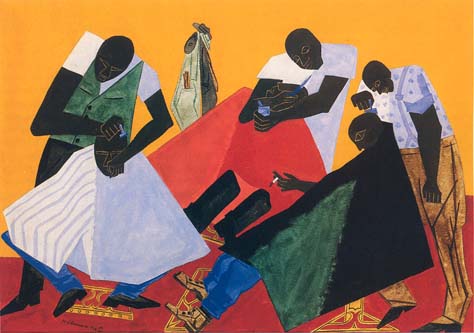
Source: Lawrence, Jacob. Barber Shop, 1946. Gouache on paper, 211⁄8" × 293⁄8". Toledo Museum of Art, Toledo, Ohio, U.S.A. Copyright © 2009 The Jacob and Gwendolyn Lawrence Foundation, Seattle / Artists Rights Society (ARS), New York. Photo: The Jacob and Gwendolyn Lawrence Foundation / Art Resource, NY.
In this work, the artist creates the appearance of depth of space by:
- employing linear perspective.
- manipulating color.
- overlapping shapes.
- changing values.
- Answer
-
Correct Response: C.
This question requires the examinee to analyze how an element of art has been used to achieve a specific effect. In this work, the artist overlapped shapes so some shapes appear to be in front of other shapes, establishing the illusion of depth in a flat picture plane.
Competency 0002
Understand the principles of design.
Use the reproduction below of Barber Shop (1946) by Jacob Lawrence to answer the question that follows.

Source: Lawrence, Jacob. Barber Shop, 1946. Gouache on paper, 211⁄8" × 293⁄8". Toledo Museum of Art, Toledo, Ohio, U.S.A. Copyright © 2009 The Jacob and Gwendolyn Lawrence Foundation, Seattle / Artists Rights Society (ARS), New York. Photo: The Jacob and Gwendolyn Lawrence Foundation / Art Resource, NY.
The repetition of shapes and diagonals in this work creates a sense of:
- radial balance.
- emphasis.
- endless space.
- rhythm.
- Answer
-
Correct Response: D.
This question requires the examinee to analyze how a principle of design has been used to achieve a specific effect. In this work, the artist created a sense of rhythm by repeating the shapes of the figures' heads and hands and the diagonal lines demarcating the edges of the clients' smocks and the barbers' arms.
Competency 0003
Understand media, tools, technologies, techniques, and processes used in drawing.
Which of the following would be most accurately captured using gesture drawing?
- the fine details of a cut-glass vase
- the texture of a rock wall
- the stance of a figure
- the contrast of a strongly lit still life
- Answer
-
Correct Response: C.
This question requires the examinee to recognize the effect of a particular drawing technique. Gesture drawing is well suited to figure drawing because the focus of gesture drawing is on capturing the essential shape and expressive posture of a figure.
Competency 0004
Understand media, tools, technologies, techniques, and processes used in painting.
To lighten the value of a color when working with transparent watercolor paints, an artist would typically:
- reduce the amount of water mixed into the paint.
- paint a dark color in an adjacent area.
- thin the paint with water.
- mix the color with its complement.
- Answer
-
Correct Response: C.
This question requires the examinee to understand a characteristic of watercolor paints. Transparent watercolor paints allow the color of the support to show through them. To create a lighter value of a transparent watercolor, an artist would dilute the paint with water, thereby applying less pigment and allowing more of the light color of the support to show through.
Competency 0005
Understand media, tools, technologies, techniques, and processes used in printmaking.
Which of the following safety precautions will best help prevent injury during the process of making a linocut print?
- cutting toward the body
- using a bench hook to secure the linoleum
- wearing work gloves
- drawing the design on the linoleum before cutting
- Answer
-
Correct Response: B.
This question requires the examinee to demonstrate knowledge of safety issues in printmaking. Because cutting a piece of linoleum for a relief print requires working with sharp tools that could lead to injury, it is important to keep the linoleum secure when cutting. A bench hook keeps the linoleum in place.
Competency 0006
Understand media, tools, technologies, techniques, and processes used in sculpture.
Which of the following is an example of a subtractive sculptural process?
- assemblage
- relief carving
- papier-mâché
- casting
- Answer
- Correct Response: B. This question requires the examinee to demonstrate knowledge of the characteristics of sculpting processes. Relief carving is a subtractive process in which the sculptor removes media until the subject projects from the background of the media but remains part of it.
Competency 0007
Understand media, tools, technologies, techniques, and processes used in photography,
video/film art, multimedia arts, and design arts.
In photography, adjusting which of the following would result in all the objects in the image appearing closer to the camera?
- aperture
- shutter speed
- focal length
- flash
- Answer
-
Correct Response: C.
This question requires the examinee to demonstrate knowledge of the characteristics of photographic techniques. Focal length is the magnification power of a lens. When focusing on objects for a photograph, increasing the focal length of the lens will make the objects appear larger and, therefore, closer to the camera.
Competency 0008
Understand media, tools, technologies, techniques, and processes used in functional
arts, such as ceramics, fiber arts, and jewelry.
Which of the following poses the greatest safety risk for an artist who is creating a ceramic work?
- improper ventilation
- using grog as an additive
- insufficient wedging
- inadequate drying time
- Answer
-
Correct Response: A.
This question requires the examinee to demonstrate knowledge of safety issues concerning ceramics. Unintended inhalation of hazardous dust and fumes, when mixing dry clay and working with lead glazes for example, poses the greatest safety risk for an artist who is creating a ceramic work. Adequate ventilation in the studio is essential for preventing the health risks associated with inhaling such substances.
Competency 0009
Understand the purposes and functions of art in cultures and societies throughout
history.
In traditional Tibetan Buddhist sandpainting, monks work in groups for many days pouring brightly colored powders on a flat surface to create complex, symbolic compositions known as mandalas. After a short time, the work is destroyed, representing the impermanence of life. This is an example of the function of art as a:
- form of entertainment.
- means of social commentary.
- spiritual practice.
- documentation of history.
- Answer
-
Correct Response: C.
This question requires the examinee to demonstrate knowledge of the function of the practice of sandpainting in Tibetan Buddhist culture. The ritual of constructing and destroying sandpaintings is considered a spiritual practice and a step in the Tibetan Buddhist path to enlightenment.
Competency 0010
Understand how works of art and architecture relate to their historical context
(e.g., cultural, political, social, religious, technological).
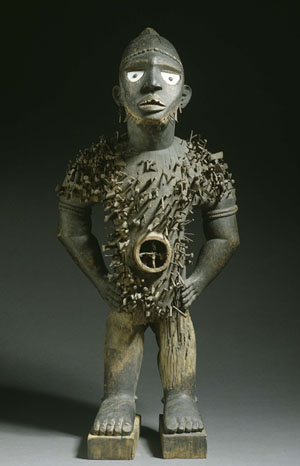
Source: Unknown artist. Nkondi tatu oath taking figure. Bildarchiv Preussischer Kulturbesitz/Art Resource, NY. Used with permission.
In the Kongo culture, nkisi nkonde sculptures, such as the one shown above, are believed to become endowed with specific powers through the placement of particular substances into the container near the figure's abdominal region. Individuals can then activate these powers in times of need by driving a nail or other object into the figure. This use of art indicates that the Kongo culture values art as a way to:
- unite the community.
- exert control over life events.
- memorialize ancestors.
- express personal emotions.
- Answer
-
Correct Response: B.
This question requires the examinee to demonstrate knowledge of how an artwork from the Kongo culture relates to its cultural and historical context. Individuals interact with the nkisi nkonde sculptures to summon spirits to help them with a wide range of concerns, such as curing illness and stimulating crop growth. In this way, the Kongo people value art as a way to exert control over their lives.
Competency 0011
Understand how art from various cultures and historical periods influenced and was
influenced by art from other cultures and historical periods.
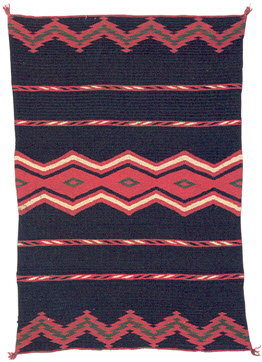
Source: Unknown artist. Image of Navajo blanket, Banded background,
1870–1875. Length 75", Natural History Museum of Los Angeles County, William
Randolph Hearst Collection, Anthropology Department, Natural History Museum of Los
Angeles County. Used with permission.
The geometric patterns used on the woven Navajo blanket shown above reflect an influence
from the artistic traditions common in:
- Alaska.
- Mexico.
- Hawaii.
- Canada.
- Answer
-
Correct Response: B.
This question requires the examinee to demonstrate knowledge of how artwork from the Navajo culture was influenced by art from another culture. In the 1860s, the Navajo people were forcibly relocated to New Mexico by the U.S. government. It was there that Navajo weavers were influenced by the designs of Mexican serapes, woven garments that frequently featured geometric motifs.
Competency 0012
Understand the distinguishing characteristics of art from various cultures.
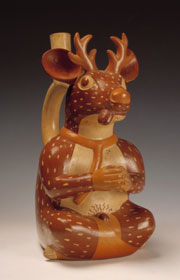
Source: Museo Larco, Lima - Perú. ML010499
The stirrup spout and animal form of the work shown above are characteristic of the early art of:
- Peru.
- eastern Europe.
- Polynesia.
- Iran.
- Answer
-
Correct Response: A.
This question requires the examinee to demonstrate knowledge of a distinguishing characteristic of art from South America. This ceramic jar's naturalistic depiction of an animal and its stirrup spout are characteristic of the art of the Moche people of Peru.
Competency 0013
Understand similarities and differences among art forms or artworks from various
cultures and historical periods.
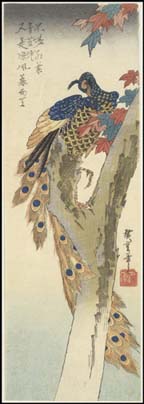 |
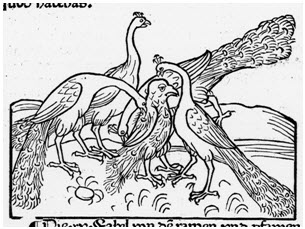 |
|---|---|
| Image 1 | Image 2 |
| Source: Image 1 Hiroshige, Utagawa. Peacock Perched on a Maple Tree in Autumn, Kujaku ni Momiji. ca. 1833. Polychrome woodblock print; ink and color on paper, 14 13/16 x 5 in. (37.6 x 12.7 cm). The Metropolitan Museum of Art/Art Resource, NY. Used with permission. | Source: Image 2 Zainer, Johan. Jay and Peacocks (Aesop, Vita et Fabulae). PML 23211. The Pierpont Morgan Library, Art Resources, NY. Used with permission. |
While the two woodblock prints shown above were created using the same medium and share similar content, which of the following is a significant difference between them?
- Image 1 is a realistic depiction of the subject, while Image 2 is abstract.
- Several blocks were required to print Image 1, while only one was required for Image 2.
- Image 1 is a portrait of the subject, while Image 2 is a portrait that presents the subject as a symbol.
- Line is used in Image 1 primarily to define edges, while line is used in Image 2 primarily to create asymmetrical balance.
- Answer
- Correct Response: B. This question requires the examinee to analyze a significant difference between two artworks. Woodblock printing is a type of relief printing in which artists remove the surface areas of the block around the design. Incorporating more than one color in a woodblock print generally requires one block per color. Image 1 features several ink colors and therefore required several blocks for printing, while Image 2 has one ink and required only one block for printing.
Competency 0014
Understand ways in which visual images may influence current cultural and societal
issues.
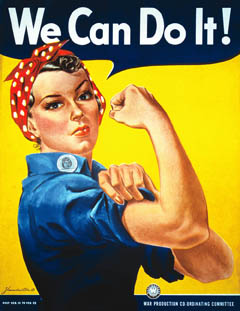
Source: We can do it! Courtesy National Archives, photo no. 535413. Creator: Office for Emergency Management. War Production Board. 1/1942-11/3/1945
In this work, the artist uses the combination of text and image for the purpose of:
- confronting gender stereotypes.
- satirizing the genre of advertising.
- exploring class issues.
- promoting a healthy lifestyle.
- Answer
-
Correct Response: A.
This question requires the examinee to demonstrate knowledge of ways in which visual images in popular media influence culture and society. When the United States became involved in World War II, manufacturing jobs were vacated by men who were needed to fight in the war. In an effort to encourage women to fill those jobs, corporations and the United States government created propaganda posters that equated the importance of work with fighting in the war. The text and image used in this poster portrays women as strong and capable of doing the work previously done by men, thus having the effect of confronting the stereotype that women could not work outside the home.
Competency 0015
Understand aesthetic concepts.
Which of the following best defines a culture's aesthetic?
- the features that differentiate the culture's artworks from other cultures' artworks
- the degree to which art is incorporated into the culture's daily life
- the degree of originality with which artists in the culture use art media, tools, processes, and techniques
- the criteria used within the culture to determine the artistic value of an object
- Answer
-
Correct Response: D.
This question requires the examinee to demonstrate knowledge of aesthetic concepts in addressing aesthetic questions. The aesthetic of a specific culture is defined by the criteria the culture uses to determine an object's artistic value.
Competency 0016
Understand critical analysis and interpretation of artworks.
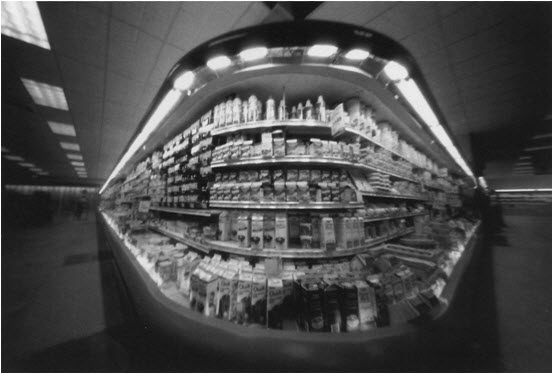
Source: Padula, Warren. Mouth, 1996. Reprinted by permission of Warren Padula.
The most significant effect of the artist's use of viewpoint in this photograph is that it:
- obscures the true essence of the subject.
- creates a visual metaphor that reinforces the work's message.
- captures an image that would otherwise be too fleeting to see.
- manipulates scale to create a false sense of depth.
- Answer
-
Correct Response: B.
This question requires the examinee to apply critical processes and principles to analyze a work of art. For this photograph, the artist used a unique viewpoint that resulted in the long supermarket food cooler having the appearance of a gaping mouth. This visual metaphor reinforces the work's comment on the enormous appetite of consumer culture.
Competency 0017
Understand connections between visual arts and other disciplines.
Which of the following movements in European writing, music, and visual art was inspired by French political philosopher Jean-Jacques Rousseau's ideas that humans are naturally positive, compassionate beings who lose this nature when corrupted by society?
- Enlightenment
- humanism
- romanticism
- Reformation
- Answer
-
Correct Response: C.
This question requires the examinee to analyze a way in which a philosophical concept is explored through the visual arts. Jean-Jacques Rousseau believed that humanity in its most primitive state is essentially kind and decent, and that society is a corrupting influence on these positive human virtues. His idea that the path to freedom from such corruption was through human feeling instead of through thinking inspired the artists of the romantic movement.
Competency 0018
Understand careers and opportunities for lifelong learning in the visual arts.
As part of the process of creating an image for a magazine advertisement, a graphic designer is making note of the product being advertised, the size of the advertisement, the target audience, and the client's requests and expectations. In which of the following steps in the creative problem-solving process is the designer engaging at this point?
- defining the problem
- brainstorming possible ideas
- evaluating possible solutions
- selecting a solution
- Answer
-
Correct Response: A
This question requires the examinee to demonstrate knowledge of creative problem-solving processes used in an art-related career. Before graphic designers can effectively brainstorm ideas, they must take the important first step of defining the problem by considering important issues such as audience and client expectations.